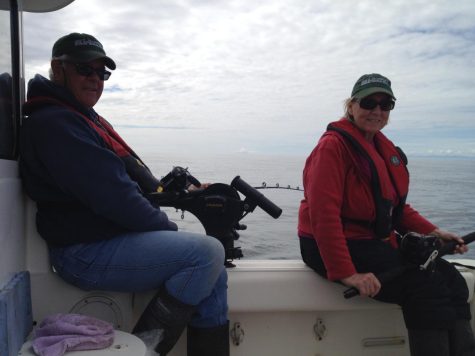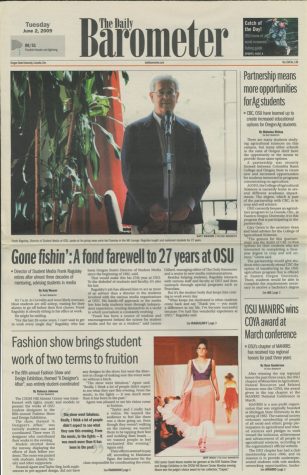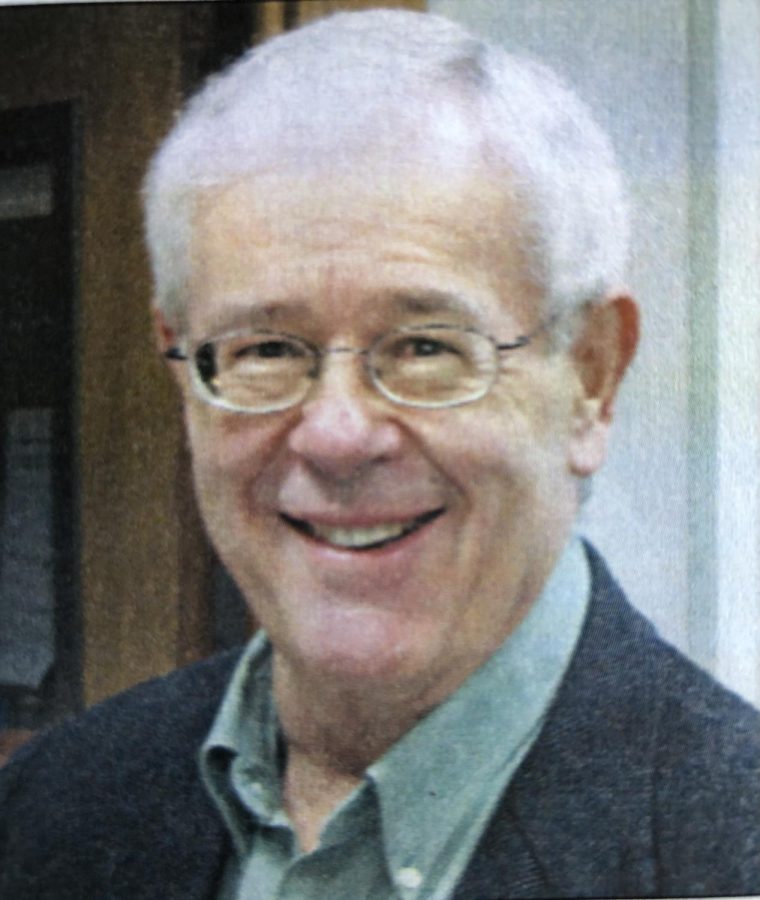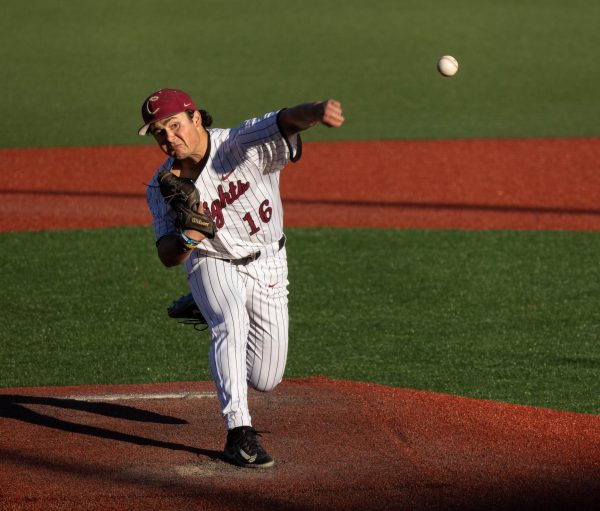Former Barometer adviser Frank Ragulsky dies at 75, leaving behind enduring legacy in college media
Frank Ragulsky, former adviser to The Daily Barometer and director of Student Media at Oregon State University from 1982 to 2009. Ragulsky died on June 30 in Corvallis, Ore. at 75 years old.
July 21, 2022
Those who knew Frank Ragulsky likely heard him say, “I have been to the bank,” when he reached work at seven in the morning.
Generally, that meant he had already caught a couple of steelhead trout on an early morning fishing trip before heading to Oregon State University, where he worked as a dedicated adviser for The Daily Barometer and director of Student Media from 1982 to 2009.
A loving husband, father of two and grandfather of five, Ragulsky died from cancer peacefully in Corvallis, Ore. on June 30 with his wife, Jane Ragulsky, by his side.
Jane first met Ragulsky in the fall of 1966.
“I was a freshman in college and he was a junior,” Jane Ragulsky said. “He was in my biology class and he noticed me. I had noticed him, he was in student government, wore a school blazer on the days of student government, so Frank stood out from the other guys. He called me on my 18th birthday.”
Ann Robinson, former assistant director of Student Media from 1982 to 2012, worked for Ragulsky during her time at OSU. Later, when they both retired, she became close friends with him and his wife.
“He seemed sort of old-fashioned,” Robinson said.
“He always wore a tie and jacket—never jeans. He took his job seriously. He always arrived early for everything. He was a good listener and great storyteller. When I first met him he was in his 30s with two small children. Those kids are in their 40s now with kids of their own.”
Just before Ragulsky retired, Robinson said he and his wife built a house in Homer, Alaska and bought a boat.
“They both took navigation and instrument training so that they were highly qualified to go out in the ocean trolling for salmon or catching halibut,” Robinson said. “I had the privilege of learning to catch halibut and salmon on his boat and on the nearby Soldotna River. I might never have visited Alaska if it wasn’t for Frank and Jane.”


Ragulsky was inspired to be a journalist by a high school experience, according to his wife.
“He had a journalism class and he was on the newspaper staff and went to a Catholic high school, and there was a nun there that just inspired him,” Jane Ragulsky said. “She came into a room and said, ‘I want you, you and you, come with me,’ and that was how it started, and he just liked it from that age.”
Frank Ragulsky’s love for students and teaching drove his success, according to Kami Hammerschmith, who first met him as a 17-year-old attending yearbook camp at OSU. Years later, she went on to work with Ragulsky as assistant director of Student Media from 1995 to 2016.
“I ended up attending OSU and he was my advisor as I worked for the Beaver Yearbook,” Hammerschmith said. “If a student made a mistake, Frank would support them and make it a learning experience. He helped many students find an internship or job. He was the president of the Western Association of University Publication Managers—a national organization of student media directors—twice, and had media contacts across the country. In 2007, a colleague at The Oregonian asked him about bringing the High School Journalism Institute to OSU, a week-long summer camp for students underrepresented in media. The camp came to OSU in 2008 and still exists today.”
The HSJI will be held this summer from July 30 to Aug. 6 on OSU’s Corvallis campus, after a hiatus due to the COVID-19 pandemic.
From 1997 to 2001, Scott Johnson worked at The Barometer as a student reporter under Ragulsky’s guidance and later worked with him again at Hewlett-Packard—commonly known as HP.
“The first thing that’s easy to remember about Frank is his huge smile,” Johnson said. “He was an optimist and always could put a positive spin on a situation.”
Ragulsky understood that college is a place for students to learn, according to Johnson, and he knew sometimes that meant you had to fail to get better.
“I appreciate that he truly let students run the newsroom without being heavy-handed, but he was always there if you needed advice,” Johnson said. “He was a great guide and mentor because he never told you exactly what to do, but instead laid out scenarios and let you make a decision.”
Steve Clark, vice president of OSU University Relations and Marketing, said he engaged with Ragulsky frequently when Clark was an Oregon newspaper publisher from 1983 to 2011.
“He was a wonderful person, warm, happy and caring.” Clark said. “He loved teaching and supporting student journalists. I am very sad that he has passed. Frank will be long-remembered by many journalists working across the country and even the world.”
Ragulsky had a 27-year impact on student media and OSU, according to Hammerschmith.
“For some of his years, there was no journalism or media degree program but Frank worked with students to continue a daily newspaper, a yearbook, a literary magazine, and a radio and TV station,” Hammerschmith said. “They all continued with a high quality due to Frank’s trainings since students couldn’t learn it elsewhere on campus.”

In an interview in March 2021 for the 125th-anniversary issue of The Barometer, Ragulsky said he and other advisers offered help anytime students asked for help, but let them go on their own—their only requirement was that students were accurate and responsible.
“We let them go because they were the best at their reporting,” Ragulsky said in the interview last year.
Matthew LaPlante, an associate professor of journalism at the University of Utah, was part of The Barometer team as a student reporter in 2001, when the newspaper won national awards with Ragulsky as journalism adviser.
“Frank let us be us,” LaPlante remembered.
“When we failed as reporters and students—and, alas, sometimes as decent human beings—he allowed us to own our mistakes, to learn from public criticism, and to apply those experiences to tomorrow, next week and next year. We failed often, and he was there to listen to us when we felt overwhelmed by those experiences, to remind us that failure is part of being a student, and to tell us to buck up, get back to work and strive to make better decisions. But he didn’t shield us from the consequences of our actions, and he didn’t tell people that they were wrong to criticize us when we screwed up, which happened a lot.”
In their “far less common” successes, LaPlante remembered that Ragulsky allowed the student reporters to bask in the moment.
“When I called him from the Society of Professional Journalists’ conference in Fort Worth, Texas to tell him that I had won the national award for feature writing and that our newspaper had been named the top college paper in the nation, I said ‘Congratulations, boss,’ and he replied, ‘I’m not the one who should be congratulated,’” LaPlante said.
“In the days and weeks that followed, when we were being lauded by school officials and reported on by journalists who cover journalism, Frank never sought or accepted credit for what had happened. Today, I am a college professor whose students sometimes win national awards, and so I have had many occasions to think about how remarkable this was: Frank was the adviser of a newspaper from a school with no journalism program and very few journalism classes, and which somehow managed to produce amazing journalism and win national awards, but he didn’t take credit.”
Ragulsky’s innate humility and generosity were traits that other colleagues mentioned frequently when sharing stories about him.
“He wanted to impact students, but never for personal recognition,” Hammerschmith said.
The most Ragulsky did was to have a bunch of mugs made, LaPlante recalled—white with an orange Barometer logo and, under that, the words “Best Student Newspaper in the Nation.”
“I do know he kept one on his desk,” LaPlante said. “I’ve got one on my desk, still, too, and I’ve often thought about putting it away somewhere where it won’t be accidentally broken, but I haven’t done that because I like what it reminds me of.”
“When students are allowed to truly feel their failures, and really revel in their successes, amazing things can happen. I learned that from Frank, and I’ll always be grateful for that lesson.”

























































































































